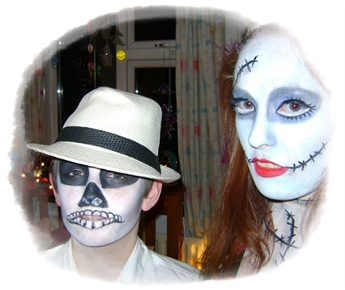Halloween is a celebration observed in several countries on October 31, the eve of the Western Christian feast of All Hallows’ Day. It begins the three-day observance of Allhallowtide, the time in the liturgical year dedicated to remembering the dead, including saints (hallows), martyrs, and all the faithful departed.
It is widely believed that many Halloween traditions originated from ancient Celtic harvest festivals, particularly the Gaelic festival Samhain. Samhain marks the end of the harvest season and the beginning of winter or the “darker half” of the year. Traditionally, it is celebrated from October 31 to November 1, as the Celtic day began and ended at sunset. This is about halfway between the autumn equinox and the winter solstice. Samhain was seen as a liminal time, when the boundary between this world and the Otherworld could more easily be crossed. This meant the Aos Sí, the ‘spirits’ or ‘fairies’, could more easily come into our world. The tradition of dressing up is believed to have been a way of imitating, and disguising oneself from, the Aos Sí who some believed could take you back with them to their world. If they saw you looking like a spirit or deceased being they would ignore you as a potential candidate for bringing back with them.

The Day of the Dead (el Día de los Muertos), is a Mexican holiday where families welcome back the souls of their deceased relatives for a brief reunion that includes food, drink and celebration. A blend of Mesoamerican ritual, European religion and Spanish culture, the holiday is celebrated each year from October 31- November 2. While October 31 is Halloween, November 1 is “el Dia de los Inocentes,” or the day of the children, and All Saints Day. November 2 is All Souls Day or the Day of the Dead. According to tradition, the gates of heaven are opened at midnight on October 31 and the spirits of children can rejoin their families for 24 hours. The spirits of adults can do the same on November 2.
October 31 is in the Autumn season which, in Traditional Chinese Medicine (TCM) is associated the Metal Element. The Metal Element helps us to be ‘inspired’ and to ‘let go.’ It governs the functioning of our Lungs and Colon/Bowels. November can be a time when we remember the dead and there is a certain poignancy to this experience. In the Nei Jing, one of the key ancient acupuncture texts, it says that the season of Autumn “…gives to the human voice the ability to weep and to wail.”
The Tai Chi Foundation program Five Element Qigong is a practical way to support your Metal Element process. You can learn more here.
Five times each year, in Winter, Spring, Summer, Late Summer, and Autumn, TCF offers seasonal Tunings— practices in which hundreds of people worldwide align with the energy of a particular season according to Chinese medicine and philosophy. On October 13, 2024, White Crane Breathing, a free 28-day qigong Tuning related to the Metal Element will begin. Click to learn more and to register.
***
The Tai Chi Foundation (TCF) is a not-for-profit educational organization that promotes, funds, and teaches programs that enable people to learn tai chi chuan and embody its principles.
The Tai Chi Foundation’s mission is to improve health, well-being, and awareness through the study, practice, and teaching of tai chi and qigong by an increasing number of people worldwide. Check out our regular course offerings. Sign up for our newsletter for updates on upcoming classes and events, and take some time to explore our free video series.
There are over 300 TCF-affiliated instructors teaching tai chi classes in 30 cities around the world. Find a class in your area, become a member, and support TCF in making the world a healthier and more mindful place today.
By Sean O’Neill – Lic Ac.
Copyright 2020 and 2024 Tai Chi Foundation
 Dịch
Dịch

Give a Reply